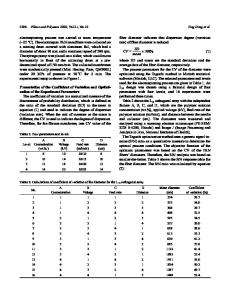Post-Processing Electrospun Fibers
- PDF / 295,044 Bytes
- 7 Pages / 432 x 648 pts Page_size
- 11 Downloads / 368 Views
Post-Processing Electrospun Fibers Caroline L. Schauer, Marjorie S. Austero and Amanda C. Toth Department of Materials Science and Engineering, Drexel University, 3141 Chestnut St., Philadelphia, PA 19104, USA ABSTRACT Electrospinning is an inexpensive and simple method of producing non-woven fiber mats. Electrostatic forces are employed to produce the mats, which intrinsically have larger specific surface to volume ratio and smaller pores than traditional fibers. Fibrous mats are typically used in a wide variety of industries such as filter media, tissue engineering, and sensors. Chitosan, the N-deacetylated derivative of chitin, is environmentally friendly, non-toxic, biodegradable, and anti-bacterial. However, due to chitosan’s solubility in aqueous acids, it is electrospun using trifluoroacetic acid (TFA). Modified chitosans, such as carboxymethylchitosan, are currently under investigation as a means of creating designed nanofibrous mats with specific chemistries. However, typically an entirely new set of electrospinning conditions has to be developed for each novel chemistry due to differences in solubility and viscosity. In the present study, we have electrospun chitosan mats and post-processed the fibers. Two different post-processing conditions were employed. One post-production procedure, featuring vapor-phase glutaraldehyde, effectively crosslinks the fiber mats utilizing a Schiff base imine functionality. In another post-processing procedure, the as-spun mats are solution-phase post-processed by chemically functionalizing the mats with cyano, carboxylic acids and thiol groups. While both methods maintained fiber shape and characteristics, there is a definite increase in fiber diameters due to processing. FTIR, NMR, SEM and tensile testing have been performed on the pre- or post-processed fiber mats. Investigations into the percent modification are currently underway. INTRODUCTION Biopolymer fibers made by electrospinning have gained increased attention due to their increased surface area to volume ratio, porosity and reactivity than traditional fibers. Electrospinning is an inexpensive, simple, flexible and scalable method to fabricate randomly oriented biopolymer fiber mats down to the nanoscale size. Chitosan (CS), the N-deacetylated derivative of chitin, the second most abundant biopolymer in nature, is environmentally friendly, non-toxic, biodegradable, renewable and can be electrospun into fibers. The presence of functional groups in CS, such as amine or hydroxyl, gives rise to its functionality that can be utilized for diverse applications. CS can also be modified by the addition of cyano, carboxylic acid and thiol groups that improves its solubility and enhances specificity in binding to specific molecules or metals. In the present study, two post-processing techniques have been employed to improve the electrospun CS fiber’s chemistry. One, fiber mats containing crosslinkers were fully crosslinked in the presence of base vapor and elevated temperatures. In another technique, the as-spun mats were m
Data Loading...











